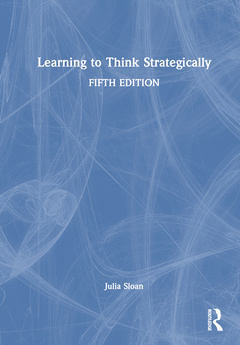Learning to Think Strategically (5th Ed.)
Auteur : Sloan Julia

Strategic thinking has become a core capability for business leaders globally. Now in its fifth edition, this comprehensive text is an original primer for how successful strategists learn to think strategically. It delineates and defines strategic thinking as an advanced, conceptual cognitive capability, focusing on the nonlinear and informal nature of strategic thinking. The book highlights the role of informal learning, underscores the relevance of engaging in the arts, and has global application for those tasked with making strategy in this rapidly changing world.
This edition has been fully updated to include a new chapter on AI and strategic thinking, as well as expanded coverage of the critical reflective process and the challenges of introducing strategic thinking across cultures. Additional pedagogical features have been incorporated, including more discussion questions and exercises to engage debate and reflection, additional scenarios, and case vignettes.
Learning to Think Strategically is vital reading for MBA, strategy, leadership development, and executive education students. Its practical nature also makes it valuable for business and policy executives, as well as for managers and emerging leaders looking to develop their strategic thinking skills. Online resources include PowerPoint slides, a test bank, and video clips.
Part 1: How did we Get Here? 1. Chronology of Strategy 2. Contemporary Competing Views of Strategy 3. Global Sketches of Strategy; Part 2: How do we Learn to Think Strategically? 4. What is Strategic Thinking? 5. Informal and Formal Learning Defined 6. Context and Learning Transfer as Factors in the Strategic Thinking Process 7. Three-Stage Model for Learning Strategic Thinking; Part 3: How do we Get Started? 8. Framing as a Structural Process 9. Learning Domains Used for Strategic Thinking; Part 4: How do we Test the Foundation? 10. Role of Critical Dialogue in the Strategic Thinking Process 11. Role of Critical Inquiry in the Strategic Thinking Process; 12. Role of generative artificial intelligence in learning strategic thinking Part 5: How do we "Know" This?: Intuition as an Outgrowth of Experience 13. Intuition as a Must-Have for Learning to Think Strategically 14. The Roles of Analysis and Intuition in Strategic Decision Making Part 6: What Role Does Culture Play? 15. The Role of Culture in Strategic Thinking 16. Debunking the Myth of the Chosen Few: Five Attributes; Part 7: How to Become a Stronger Strategic Thinker? 17. Strengthen Strategic Thinking Through the Arts 18. Three Unconventional Approaches that Support Learning to Think Strategically; Part 8: Where do we go from Here? 19. Where We’ve Come From and Where We Can Go: Some Suggestions
Julia Sloan is Professor of Strategic Thinking at Columbia University, USA, and Principal of Sloan International, a New York-based consulting firm specializing in strategic thinking for global business and government leaders. A Fulbright Fellow and Researcher-in-Residence Fellow, she has also been recognized with numerous teaching awards.
Date de parution : 06-2024
17.4x24.6 cm
Thèmes de Learning to Think Strategically :
Mots-clés :
Strategic Management; Strategy; Strategy Safari; Strategic Planning; Corporate Strategy; Culture and Strategy; Strategic Learning; Strategic Practice; Strategy in Practice; History of Strategy; Strategic Thinking; Future of Strategy; Contemporary Strategy; Formal Learning; Informal Learning; Leadership; Strategic Leadership



